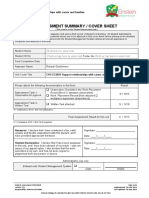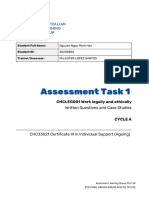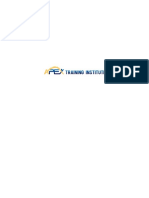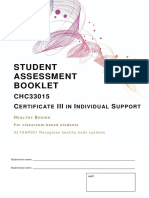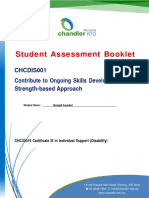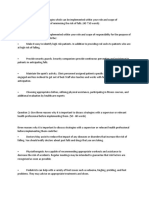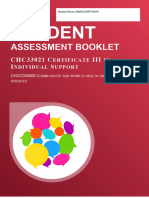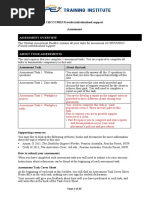HLTINF006 Student Assessment Task 1 - 16252 - Rebeca Raducu
HLTINF006 Student Assessment Task 1 - 16252 - Rebeca Raducu
Uploaded by
Rebeca RaducuCopyright:
Available Formats
HLTINF006 Student Assessment Task 1 - 16252 - Rebeca Raducu
HLTINF006 Student Assessment Task 1 - 16252 - Rebeca Raducu
Uploaded by
Rebeca RaducuCopyright
Available Formats
Share this document
Did you find this document useful?
Is this content inappropriate?
Copyright:
Available Formats
HLTINF006 Student Assessment Task 1 - 16252 - Rebeca Raducu
HLTINF006 Student Assessment Task 1 - 16252 - Rebeca Raducu
Uploaded by
Rebeca RaducuCopyright:
Available Formats
HLTINF006 Apply basic principles and practices ofProvider
CRICOS infection
Code 02934D
RTO Number 121952
prevention and control
Student Assessment
Student Assessment
Task 1: Questioning
HLTINF006
Apply basic principles and practices
of infection prevention and control
CHC30121 Certificate III of Early Childhood
Education and Care
HLTINF006 Apply basic principles and practices of infection prevention
CRICOS Provider Code 02934D
and control Page 1 of 10 RTO Number 121952
Student Assessment - Version 1.0 May 2023
HLTINF006 Apply basic principles and practices of infection
prevention and control
Student Assessment
ASSESSMENT TASK 1 – QUESTIONING
Student Details
☐ I have read and understand unit information and assessment instruction
Student ID 16252 Date 27.06.2023
Student Name Rebeca Raducu
Conditions of • The student will have access to the relevant learning resources, listed under the
Assessment learning resource of this document, for this assessment.
• Questions will be completed in the student’s own time.
• Responses to the questions must be typed.
Student • This task requires you to complete a written response knowledge assessment.
Instructions for • You are required to answer all 18 questions correctly in Assessment Task 1 –
completion Questioning.
• The questions within this assessment relate directly to the integrated knowledge
contained within the unit of competencies and are fundamental to the student’s
knowledge and performance evidence. Use of correct grammar and spelling is
required to demonstrate foundation skills, so please ensure to proofread your
answers prior to submission.
• APA referencing must be used where original sources have been used. Do not copy
and paste text from any of the online sources. SCEI has a strict plagiarism policy
and students who are found guilty of plagiarism, will be penalised.
• The written assessment standards (8.2) outlined in the PP77 Assessment policy
and procedure apply to this assessment task.
Explanation of the The assessment tasks use a range of instructional words throughout them – such as
common command ‘compare’ and ‘list’. These words will guide the student and yourself as to the level of
words used in the detail that must be provided in their answers. Some questions will also tell you how
Assessment Task many answers the students need to give – for example, ‘Describe three strategies…’.
Use the below glossary to guide you on interpreting the words in the tasks:
• List - You must record short pieces of information in a numbered or bulleted
form with one or two words or sentences on each line.
• Outline = provide the main facts about something, more than naming, but not
a detailed description. You must give a brief description of the main facts or
sequence of events about something. The length of the response should be
guided by what you are required to outline. As long as you include the main
facts or points, then that’s enough.
• Describe = Provide full details of characteristics and/or features, more
needed than an outline or than a list. This means you should outline the most
noticeable qualities or features of an idea, topic or the focus of the question
• Explain - This means you need to make something clear or show your
understanding by describing it or providing information about it. You will need
to make clear how or why something happened, or something is the way it is.
• Discuss = Provide a reasonable argument to discuss cause and effect and/or
make links between things clear in your own words
HLTINF006 Apply basic principles and practices of infection prevention
CRICOS Provider Code 02934D
and control Page 2 of 10 RTO Number 121952
Student Assessment - Version 1.0 May 2023
HLTINF006 Apply basic principles and practices of infection
prevention and control
Student Assessment
• Define – This means you should explain the meaning or interpretation of a
term or concept in your own words, including any qualities which are
essential to understanding.
• Analyse = Identify parts, the relationship between them, and their
relationships with the whole. Draw out and relate implications
• Demonstrate = Present, show or illustrate through example or action
Assessment • You will be provided with a briefing on the assessment and the opportunity to seek
Procedure clarification on the conduct of the assessment.
• You may seek clarification at any point in time during the assessment task. If you
feel you need more time to complete the assessment, you must negotiate the time
needed with the assessor prior to the assessment due date.
• Following the assessment, your responses will be assessed and marked as
appropriate. Where responses have been assessed in one (1) or more questions as
unsatisfactory, students will be required to resubmit these questions. For more
information, detailed information can be found in PP77 Assessment Policy and
Procedure
Due Date • 14 days after the unit completion date as outlined in the PP77 Assessment Policy
and Procedure.
Questions:
1. Complete the question regarding standard precautions for infection prevention and control.
a. What are standard precautions for infection prevention and control and when should they be
used?
Hand hygiene, PPE like gloves, gowns, masks and eye protection, safe handling of contaminated
equipment
b. What is your state/territory legislation relevant to infection control in ECEC Centre? Outline the
standard precautions that must be implemented in your centre.
VIC - infection control guidelines, protocol listed(what should we be wearing) PPE, cleaning,
waste control, safe handling and disposal of sharp, using non-touch techniques and not going to
work when ill.
c. What is the Australian Government body that developed Australian Guidelines for the Prevention
and Control of Infection in Healthcare?
Australian Comision and safety and Quality in healthcare.
d. Describe the purpose of the Australian Guidelines for the Prevention and Control of Infection
The purpose is having effective infection prevention and control (high quality, evidence based)
The guidelines are developed to support prevention and control infections.
2. Explain the requirements of PPE under Regulation 44–47 of the Model WHS Regulations. You can
access the Regulations at safeworkaustralia.gov.au/model-whs-regulations (PC 2.3)
-Minimise risks to health and safety- suitable size and fit-being comfortable while wearing PPE,
maintain / replaced and raped to minimise risk-suitable for the nature of work and any hazards
associate with her, use a worn by workers, workers need to be train or given instructions for use of
PPE, PCBU are responsible for using PPE (supervisor or manager are responsible if you using PPE)-
as a employee you are responsible to use PPE as directed.
HLTINF006 Apply basic principles and practices of infection prevention
CRICOS Provider Code 02934D
and control Page 3 of 10 RTO Number 121952
Student Assessment - Version 1.0 May 2023
HLTINF006 Apply basic principles and practices of infection
prevention and control
Student Assessment
3. Complete the missing fields (hazard type or consequence) in the table below. (PC 1.2)
Hazard Potential harm/consequence
Loud noise Headache, hearing damage, irritating
Electricity Can cause shock, burns, fire or even death.
Stress Aggression, violence, anxiety, difficulty in concentrating, depression
chemicals Can cause respiratory infections or illness, cancer, acid burns or dermatitis.
Manual tasks Back injury, repetitive movements
Working from a height Fall, slip or trip, bruises, fractures, death
Machinery and If hit or caught, can cause fractures, bruises, dislocations, lacerations, serious
equipment injury or death.
Infectious material Waste disposal
4. In one short paragraph, explain the Australian Government: Department of Health and Aged Care
Guidelines for the Infection control in child care settings. (PC 1.4)
https://www1.health.gov.au/internet/main/publishing.nsf/Content/cda-pubs-cdi-1997-cdi2122-
cdi2122a.htm
In order to minimise these risks, it is necessary to apply infection control principles. Infection
risk factors are outlined and recommendations for immunisation, preventative practices, the use
of antibiotics and outbreak management are presented like: Increased risk of infections,
Immunisation of children, Immunisation and screening of staff, Hand washing and the use of
gloves, Cleaning and disinfection, Separation of children in nappies from older children,
Antibiotics in outbreak control, Cohorting of infectious children, Education, surveillance and
reporting
5. Describe how each of the following standard precautions are used to prevent infectious agents
spreading from one person to another. (PC 2.4)
Standard precaution How it is used to stop infection spreading
Respiratory hygiene Cover your mouth and cough in your elbow and when using your hands use a
and cough etiquette tissue a dispose it appropriately and wash your hands or use alcohol. Wearing a
mask
Handling of waste Wearing gloves, follow procedures in disposing appropriately, take the waste out
in the waste area by making sure it is disposed in a correct way, you can use
a trolley for transition or carry an appropriate weight so you will be able to
transfer it without holding it against your body
Handling of soiled/ Using gloves and minimise as much contact with the linen as possible and use
contaminated linen/ appropriate PPE. Prevent of getting any mucus membrane the body or blood
work clothes substance. The linen or clothes need to be located into an appropriate laundry
HLTINF006 Apply basic principles and practices of infection prevention
CRICOS Provider Code 02934D
and control Page 4 of 10 RTO Number 121952
Student Assessment - Version 1.0 May 2023
HLTINF006 Apply basic principles and practices of infection
prevention and control
Student Assessment
Standard precaution How it is used to stop infection spreading
(could be a bucket or a plastic bag). Hand hygiene must be performed and change
the gloves every time they get dirty.
Aprons/gowns Needs to be appropriate and can be reused for purpose.
Not attending work Stop spreading the infection, Minimise the contact with others
when ill
Personal hygiene ▪ Personal Care and hygiene
Hand washing, hair should be cleaned and tied back, nails short and clean.
Clean teeth and mouth.
▪ Use of clean clothing or uniform.
Regularly wash it, uniform for work should not be used in other places
▪ Management and laundering of work clothing.
Make sure you don’t travel with the clothes you are supposed to be working
in to minimise infection being spread and separate your clothes from work
clothes
6. Provide at least three infection control methods you can use in ECEC Center for each of the following.
Tasks Infection control methods
General cleanliness in Click here to enter text.Click here to enter text.When using the mop, brushed or
the center clothes, using different colours for distinguish on different rooms/places and
(i.e. housekeeping) prevent the infection spreading, using disinfectant
Cleaning up bodily Encourage regular consistent hand washing and drying procedures
fluid spills for children after all activities. Ensure that adults model hand
washing behaviour for children in an appropriate way. Have
appropriate toileting and nappy changing procedures in place.
Adopt a rigorous cleaning and sanitising program that will
minimise the risk of infection. Wear disposable gloves before
handling dirty nappies or cleaning up blood or any other body
fluid.Click here to enter text.
7. Answer the following questions:
a. In your own words, explain what the pathogens are and outline the four types of pathogens.
A pathogen is usually defined as a microorganism that causes, or can cause
a disease. Bacteria, Viruses, Fungi and Parasites
b. For each of the following pathogens, provide one example of the disease they can cause.
Pathogen Disease
Bacteria Tuberculosis, E.coli
Viruses covid
HLTINF006 Apply basic principles and practices of infection prevention
CRICOS Provider Code 02934D
and control Page 5 of 10 RTO Number 121952
Student Assessment - Version 1.0 May 2023
HLTINF006 Apply basic principles and practices of infection
prevention and control
Student Assessment
Pathogen Disease
Protozoa Giardia, malaria
Fungi Ringworm, thrush
8. Provide at least five examples of when you should wash your hands in the workplace. For each example,
identify the correct hand hygiene product that you should use.
Before and after serving meals, before and after administrate first aid, after toileting, after smoking, after
using the tissue and removing rubbish. Using soap and water. Before preparing meals use a hand
sanitiser or wash hands with water and soap.
9. Using a step-by-step approach, explain how to wash and rub your hands properly.
1.Wet your hands with clean — preferably running — water.2.Apply enough
soap to cover all surfaces of your hands and wrists.3.Lather and rub your
hands together briskly and thoroughly.4. Make sure to scrub all surfaces of
your hands, fingertips, fingernails, and wrists.5.Scrub your hands and wrists
for at least 20 seconds.6.Rinse your hands and wrists under clean —
preferably running — water.7.Dry your hands and wrists with a clean towel, or
let them air-dry.8.Use a towel to turn off the faucet.
10. Fill out the table below about the 5 Moments for Hand Hygiene.
Moment When? Why?
Before touching a child Clean your hands before touching a patient To protect the patient
infected with virus when approaching him/her against colonization and, in
some cases, against
exogenous infection, by
harmful germs carried on
your hands
Before clean/aseptic Clean your hands immediately before To protect the patient
procedure accessing a critical site with infectious risk against infection with
for the patient (e.g. a mucous membrane, harmful germs, including
non-intact skin, an invasive medical device) his/her own germs, entering
his/her body
After body fluid exposure Clean your hands as soon as the task To protect you from
risk involving an exposure risk to body fluids has colonization or infection
ended (and after glove removal) with patient’s harmful germs
and to protect the health-
care environment from germ
spread
After touching a child Clean your hands when leaving the patient’s To protect you from
infected with virus side, after having touched the patient colonization with patient
germs and to protect the
health-care environment
from germ spread
After touching a child Clean your hands after touching any object To protect you from
infected with virus or furniture when living the patient colonization with patient
surroundings germs that may be present
HLTINF006 Apply basic principles and practices of infection prevention
CRICOS Provider Code 02934D
and control Page 6 of 10 RTO Number 121952
Student Assessment - Version 1.0 May 2023
HLTINF006 Apply basic principles and practices of infection
prevention and control
Student Assessment
surroundings, without having touched the on surfaces / objects in
patient patient surroundings and to
protect the health-care
environment against germ
spread
11. Research workplace requirements for hand care for each of the following and write down how you would
follow them.
Skin Apply sunscreen and moisturiser. If having skin issue notify your manager or
supervisor. If having cuts or operations cover it and use a blue bandage.
Fingernails Short and clean, no nail polish
Jewellery/watches Removed them
12. Answer the following questions:
a. Provide an outline of routine surface cleaning procedures in a Early child care centre.
Cleaning a mop by using soapy hot water and leave it outside to dry and prevent infections if
possible out in the sunshine with head up. The bucket should be cleaned after using it with detergent
and hot water and store it upside down appropriately. Chairs and tables should be clean with warm
soapy water and cleaning solution.
b. Provide an outline of enhanced cleaning procedures in a client care centre.
Sanitising by using warm soapy water and disinfection by spray on top of the surfaces and let it dry.
13. Provide a step-by-step overview for disposing needle/syringes into a sharps container.
Put on gloves, if you come across a needle we do not attend to, instead recap it and banded it. We
need to bring the container to us that we are going to put the syringes into it. The container should
be placed on the ground or flat surface beside the syringes and do not ask anyone to hold it or hold it
ourselves. Put the syringes into the middle of the container and pick it up by our hand on the top
part. We do not crack the bell of the syringes and do not flick it. Do not use plastics twisting. Place it
into the container with the sharp down. Securely place the lead on the container and make sure the
lead is sealed. Hold the container by the top and dispose it appropriately.
14. Answer the following questions:
a) Outline the following terms in your own words:
▪ colonisation
▪ infection
▪ disease.
An infection means that pathogens are in or on the body and are causing an illness with symptoms
making a person unwell. Microorganisms can also be in or on the body, but do not make a person sick.
This is called colonization. People who are colonized will have no signs or symptoms. When our own
body's cells, tissues, and organs are being attacked and destroyed by a pathogen our own body's
receptors, cells, tissues, or organs are damaged, destroyed, or inactivated, resulting in an abnormal
state of function, we term that process a disease.
b) Explain the process of colonisation, infection and disease using the following elements:
▪ pathogen
HLTINF006 Apply basic principles and practices of infection prevention
CRICOS Provider Code 02934D
and control Page 7 of 10 RTO Number 121952
Student Assessment - Version 1.0 May 2023
HLTINF006 Apply basic principles and practices of infection
prevention and control
Student Assessment
▪ reservoir
▪ portal of exit
▪ means of transmission
▪ portal of entry
▪ the susceptible host.
You may draw a diagram to help explain your response (attach it to this page) or fill out the table below.
Pathogen Causative Agent - the pathogen (for example bacteria, virus or fungi).
Reservoir a host which allows the pathogen to live, and possibly grow, and multiply. Humans,
animals and the environment can all be reservoirs for microorganisms.
Portal of exit a path for the pathogen to escape from the host. The blood, respiratory tract, skin and
mucous membranes, genitourinary tract, gastrointestinal tract, and transplacental route
from mother to her unborn infant are some examples
Means of since pathogens cannot travel on their own; they require a vehicle to carry them to
transmission other people and places
Portal of entry a path for the pathogen to get into a new host, similar to the portal of exit. Susceptible
Host - a person susceptible to the pathogen
The An essential component in the chain of infection.
susceptible
host
15. Provide at least five risk factors that increase susceptibility of infection.
Age, Heredity, Level of stress, Nutritional status, Current medical therapy, Preexisting
disease process, Medications that weaken the immune system, Cancers that affect the
bone marrow or spread to the bone
16. Answer the following questions:
c) What does the label ‘single use only’ and ‘single patient use’ mean?
single-use medical devices should not be reprocessed
and cannot be used on a separate patient.
d) Describe the process of reprocessing reusable equipment or instruments.
Reprocessing refers to the activities required to ensure that equipment/instruments
are safe for its intended use. Reprocessing is a multistep process that includes
cleaning, inspection and assembly, functional testing, disinfection, packaging and
labelling, sterilization and storage
17. Explain the term ‘degree of pathogen exposure’ and give an example.
The degree of pathogen exposure can be described by the “infectious dose”. The
outcome of exposure to an infectious agent depends, in part, upon multiple host
HLTINF006 Apply basic principles and practices of infection prevention
CRICOS Provider Code 02934D
and control Page 8 of 10 RTO Number 121952
Student Assessment - Version 1.0 May 2023
HLTINF006 Apply basic principles and practices of infection
prevention and control
Student Assessment
factors that determine individual susceptibility to infection and disease. An
example could be coronavirus.
18. What are the steps for applying alcohol-based rub?
Apply an amount of alcohol-based handrub sufficient to cover all surfaces of hands.
Apply handrub to palm of one hand. Rub hands together covering all surfaces of hands
and fingers. Rub until handrub is absorbed. Rub right palm over left with fingers
interlaced and vice versa. Interlink your fingers. Rotational rubbing, backwards and
forwards with clasped fingers in palm. Rotational rubbing of left thumb clasped in right
palm and vice versa. Scrub all surfaces including wrists.
19. Asepsis is the absence of bacteria, viruses, and other microorganisms.
How do you ensure asepsis in the workplace by correctly using PPE?
PPE acts as a barrier between infectious materials and your skin, mouth, nose or eyes.
When used properly, it has the potential to block transmission of contaminants from
blood, body fluids, or respiratory secretions. Using correct PPE protects healthcare
workers from exposure to blood and body fluids/substances. Perform hand washing when
needed, disinfecting articles and surfaces, cleaning the environment, using sterile
equipment and sterile instruments.
Assessment Task Outcome
Result
Submission No. S = Satisfactory Date Assessed Assessor Name
NS = Not Satisfactory
Click or tap here to Click or tap here to enter
O First submission OS O NS
enter text. text.
Click or tap here to Click or tap here to enter
O Re-submission 1 OS O NS
enter text. text.
Click or tap here to Click or tap here to enter
O Re-submission 2 OS O NS
enter text. text.
The evidence presented is:
HLTINF006 Apply basic principles and practices of infection prevention
CRICOS Provider Code 02934D
and control Page 9 of 10 RTO Number 121952
Student Assessment - Version 1.0 May 2023
HLTINF006 Apply basic principles and practices of infection
prevention and control
Student Assessment
O Valid O Sufficient O Authentic O Current
Reasonable Adjustment
Was reasonable adjustment applied to any aspects of this assessment task? (please tick)
☐ Yes ☐ No
IF YES provide a description of the adjustment applied and why it was applied.
Click or tap here to enter text.
Name of assessor: Carolyn Cullinan Date: 27.06.2023
HLTINF006 Apply basic principles and practices of infection prevention
CRICOS Provider Code 02934D
and control Page 10 of 10 RTO Number 121952
Student Assessment - Version 1.0 May 2023
You might also like
- ASSESSMENT TASK 1-CHCCCS041-CHC33021-CYCLE A-RTO WORKS-V1.0 2023 (Review)No ratings yetASSESSMENT TASK 1-CHCCCS041-CHC33021-CYCLE A-RTO WORKS-V1.0 2023 (Review)38 pages
- Hltwhs002 Student Workbook (Word) (c3) .v1.1No ratings yetHltwhs002 Student Workbook (Word) (c3) .v1.148 pages
- Assessment Task 1-Hltinf006-Chc33021-Cycle A-Rto Works V1.0 2023No ratings yetAssessment Task 1-Hltinf006-Chc33021-Cycle A-Rto Works V1.0 202317 pages
- HLTINF001 Student Assessment Task 1 - Questioning...No ratings yetHLTINF001 Student Assessment Task 1 - Questioning...10 pages
- CHCLEG001 STUDENT WORKBOOK (WORD) (C3) .v1.1No ratings yetCHCLEG001 STUDENT WORKBOOK (WORD) (C3) .v1.144 pages
- Student Assessment Booklet: CHC33015 C III I S0% (2)Student Assessment Booklet: CHC33015 C III I S26 pages
- Hltaap001 Student Workbook (Word) (c3) .v1.1No ratings yetHltaap001 Student Workbook (Word) (c3) .v1.166 pages
- Chcccs015 Student Workbook (Word) (c3) .v1.1No ratings yetChcccs015 Student Workbook (Word) (c3) .v1.142 pages
- CHCAGE001 Facilitate The Empowerment of Older People SAB v3.2 THEORYNo ratings yetCHCAGE001 Facilitate The Empowerment of Older People SAB v3.2 THEORY31 pages
- Manual Handling Case Studies Part 1 - Attempt Review PDF100% (2)Manual Handling Case Studies Part 1 - Attempt Review PDF30 pages
- CHCCOM005 Assessment Tool V1.4 Nov 2018No ratings yetCHCCOM005 Assessment Tool V1.4 Nov 201815 pages
- 8.CHCCOM005 Workplace Journal (ID 161876)No ratings yet8.CHCCOM005 Workplace Journal (ID 161876)3 pages
- 32476B/P4 Work Placement Portfolio: 1. Background/overviewNo ratings yet32476B/P4 Work Placement Portfolio: 1. Background/overview17 pages
- Case 1 Recruitment at Windsor Hospital Student Copy 1629976167334No ratings yetCase 1 Recruitment at Windsor Hospital Student Copy 16299761673348 pages
- Assessment Task 1-Chcleg001-Chc33021-Cycle A-Edu Works-V1.0 2023No ratings yetAssessment Task 1-Chcleg001-Chc33021-Cycle A-Edu Works-V1.0 202324 pages
- SAB CHCHCS001 Provide Home and Community Support ServicesNo ratings yetSAB CHCHCS001 Provide Home and Community Support Services58 pages
- CHCCCS011 Meet Personal Support Needs SAB v3.1 THEORYNo ratings yetCHCCCS011 Meet Personal Support Needs SAB v3.1 THEORY28 pages
- E1144 Module2 Assessment3 SAQrubric 32469 03 v2 3 THyde 1 01 04 2020 21590% (1)E1144 Module2 Assessment3 SAQrubric 32469 03 v2 3 THyde 1 01 04 2020 215925 pages
- CHCAGE001 STUDENT WORKBOOK (WORD) - C4A.v1.1 (2) - Completed100% (1)CHCAGE001 STUDENT WORKBOOK (WORD) - C4A.v1.1 (2) - Completed81 pages
- HLTINF001 Comply With Infection Prevention and Control Policies and Procedures SAB V3.4No ratings yetHLTINF001 Comply With Infection Prevention and Control Policies and Procedures SAB V3.436 pages
- CHCPAL001 Student Assessment Booklet - AGE (ID 98478)50% (2)CHCPAL001 Student Assessment Booklet - AGE (ID 98478)49 pages
- Student Assessment Task Task 2: CHCAGE005 Provide Support To People Living With DementiaNo ratings yetStudent Assessment Task Task 2: CHCAGE005 Provide Support To People Living With Dementia21 pages
- HLTWHS002 STUDENT WORKBOOK (WORD) (C3) .v1.1No ratings yetHLTWHS002 STUDENT WORKBOOK (WORD) (C3) .v1.147 pages
- Student Assessment Booklet: CHC33015 C III I S0% (1)Student Assessment Booklet: CHC33015 C III I S23 pages
- CHCDIS001 Contribute To Ongoing Skills Development Using A Strengths-Based.... 4No ratings yetCHCDIS001 Contribute To Ongoing Skills Development Using A Strengths-Based.... 426 pages
- Assessment Task 4 - Incident Report and Safety Meeting: HLTWHS002 Follow Safe Work Practices For Direct Care WorkNo ratings yetAssessment Task 4 - Incident Report and Safety Meeting: HLTWHS002 Follow Safe Work Practices For Direct Care Work2 pages
- CHCCCS023 Support Independence and WellbeingNo ratings yetCHCCCS023 Support Independence and Wellbeing22 pages
- Dcs - Hltwhs004 - Task 2 Case Studies.v2.190305No ratings yetDcs - Hltwhs004 - Task 2 Case Studies.v2.1903057 pages
- Answers-Hltaap001 Student Assessment. v1. 110520 (For Chc43115)No ratings yetAnswers-Hltaap001 Student Assessment. v1. 110520 (For Chc43115)18 pages
- Chchcs001 Student Workbook (Word) (c3) .v1.10% (1)Chchcs001 Student Workbook (Word) (c3) .v1.150 pages
- Topic 1: Before You Begin Determine Personal Support RequirementsNo ratings yetTopic 1: Before You Begin Determine Personal Support Requirements20 pages
- Central Australian College Hobart, Tasmania: CHCCC015No ratings yetCentral Australian College Hobart, Tasmania: CHCCC01519 pages
- CHCCOM005 Student Assessment Booklet - IS V1.0.v1.1No ratings yetCHCCOM005 Student Assessment Booklet - IS V1.0.v1.180 pages
- CHCDIV001 - Student Assessment Booklet ECEC.v2.00% (1)CHCDIV001 - Student Assessment Booklet ECEC.v2.059 pages
- Follow Safe Practices For Direct Client Care - Done0% (7)Follow Safe Practices For Direct Client Care - Done55 pages
- HLTINF006 Student Assessment_IS_v1.2 July 2023 Assessment Task 1No ratings yetHLTINF006 Student Assessment_IS_v1.2 July 2023 Assessment Task 129 pages
- Hazard Report - Checklist 2 - 16252 - Rebeca RaducuNo ratings yetHazard Report - Checklist 2 - 16252 - Rebeca Raducu4 pages
- Prescription Drug Benefit Manual: Chapter 7 - Medication Therapy Management and Quality Improvement ProgramNo ratings yetPrescription Drug Benefit Manual: Chapter 7 - Medication Therapy Management and Quality Improvement Program34 pages
- Simple Guide For Basic Nursing Interventions100% (1)Simple Guide For Basic Nursing Interventions13 pages
- A Rare Case of Terson Syndrome With Subarachnoid HemorrhageNo ratings yetA Rare Case of Terson Syndrome With Subarachnoid Hemorrhage12 pages
- Oesophagogastric Cancer Assessment and Management in Adults PDF 1837693014469No ratings yetOesophagogastric Cancer Assessment and Management in Adults PDF 183769301446924 pages
- Syphilis - Treatment and Monitoring - UpToDateNo ratings yetSyphilis - Treatment and Monitoring - UpToDate27 pages
- How To Become A Doctor in The PhilippinesNo ratings yetHow To Become A Doctor in The Philippines23 pages
- Vanden Bossche, Geert/ Curriculum VitaeNo ratings yetVanden Bossche, Geert/ Curriculum Vitae15 pages
- ENT UK Guidelines - Decontamination of Flexible and Rigid Endoscopes 2017No ratings yetENT UK Guidelines - Decontamination of Flexible and Rigid Endoscopes 201714 pages
- 0.9% Sodium Chloride Injection, USP: Prescribing InformationNo ratings yet0.9% Sodium Chloride Injection, USP: Prescribing Information8 pages
- Routine Health Information Systems A Curriculum On Basic Concepts and Practice - Facilitators' GuideNo ratings yetRoutine Health Information Systems A Curriculum On Basic Concepts and Practice - Facilitators' Guide102 pages
- CAT 1 CMT 05207 REPRODUCTIVE AND CHILD HEALTH NameNo ratings yetCAT 1 CMT 05207 REPRODUCTIVE AND CHILD HEALTH Name9 pages
- The Purpose of The Complex Document Is ToNo ratings yetThe Purpose of The Complex Document Is To2 pages
- Hospital Pharmacy and Its Organization-Lecture NotesNo ratings yetHospital Pharmacy and Its Organization-Lecture Notes13 pages
- Clinical Pharmacy - A Definition: Fahad Hussain 9/20/2010100% (1)Clinical Pharmacy - A Definition: Fahad Hussain 9/20/20104 pages
- ASSESSMENT TASK 1-CHCCCS041-CHC33021-CYCLE A-RTO WORKS-V1.0 2023 (Review)ASSESSMENT TASK 1-CHCCCS041-CHC33021-CYCLE A-RTO WORKS-V1.0 2023 (Review)
- Assessment Task 1-Hltinf006-Chc33021-Cycle A-Rto Works V1.0 2023Assessment Task 1-Hltinf006-Chc33021-Cycle A-Rto Works V1.0 2023
- HLTINF001 Student Assessment Task 1 - Questioning...HLTINF001 Student Assessment Task 1 - Questioning...
- CHCAGE001 Facilitate The Empowerment of Older People SAB v3.2 THEORYCHCAGE001 Facilitate The Empowerment of Older People SAB v3.2 THEORY
- Manual Handling Case Studies Part 1 - Attempt Review PDFManual Handling Case Studies Part 1 - Attempt Review PDF
- 32476B/P4 Work Placement Portfolio: 1. Background/overview32476B/P4 Work Placement Portfolio: 1. Background/overview
- Case 1 Recruitment at Windsor Hospital Student Copy 1629976167334Case 1 Recruitment at Windsor Hospital Student Copy 1629976167334
- Assessment Task 1-Chcleg001-Chc33021-Cycle A-Edu Works-V1.0 2023Assessment Task 1-Chcleg001-Chc33021-Cycle A-Edu Works-V1.0 2023
- SAB CHCHCS001 Provide Home and Community Support ServicesSAB CHCHCS001 Provide Home and Community Support Services
- CHCCCS011 Meet Personal Support Needs SAB v3.1 THEORYCHCCCS011 Meet Personal Support Needs SAB v3.1 THEORY
- E1144 Module2 Assessment3 SAQrubric 32469 03 v2 3 THyde 1 01 04 2020 2159E1144 Module2 Assessment3 SAQrubric 32469 03 v2 3 THyde 1 01 04 2020 2159
- CHCAGE001 STUDENT WORKBOOK (WORD) - C4A.v1.1 (2) - CompletedCHCAGE001 STUDENT WORKBOOK (WORD) - C4A.v1.1 (2) - Completed
- HLTINF001 Comply With Infection Prevention and Control Policies and Procedures SAB V3.4HLTINF001 Comply With Infection Prevention and Control Policies and Procedures SAB V3.4
- CHCPAL001 Student Assessment Booklet - AGE (ID 98478)CHCPAL001 Student Assessment Booklet - AGE (ID 98478)
- Student Assessment Task Task 2: CHCAGE005 Provide Support To People Living With DementiaStudent Assessment Task Task 2: CHCAGE005 Provide Support To People Living With Dementia
- CHCDIS001 Contribute To Ongoing Skills Development Using A Strengths-Based.... 4CHCDIS001 Contribute To Ongoing Skills Development Using A Strengths-Based.... 4
- Assessment Task 4 - Incident Report and Safety Meeting: HLTWHS002 Follow Safe Work Practices For Direct Care WorkAssessment Task 4 - Incident Report and Safety Meeting: HLTWHS002 Follow Safe Work Practices For Direct Care Work
- Answers-Hltaap001 Student Assessment. v1. 110520 (For Chc43115)Answers-Hltaap001 Student Assessment. v1. 110520 (For Chc43115)
- Topic 1: Before You Begin Determine Personal Support RequirementsTopic 1: Before You Begin Determine Personal Support Requirements
- Central Australian College Hobart, Tasmania: CHCCC015Central Australian College Hobart, Tasmania: CHCCC015
- CHCCOM005 Student Assessment Booklet - IS V1.0.v1.1CHCCOM005 Student Assessment Booklet - IS V1.0.v1.1
- Follow Safe Practices For Direct Client Care - DoneFollow Safe Practices For Direct Client Care - Done
- HLTINF006 Student Assessment_IS_v1.2 July 2023 Assessment Task 1HLTINF006 Student Assessment_IS_v1.2 July 2023 Assessment Task 1
- Hazard Report - Checklist 2 - 16252 - Rebeca RaducuHazard Report - Checklist 2 - 16252 - Rebeca Raducu
- Prescription Drug Benefit Manual: Chapter 7 - Medication Therapy Management and Quality Improvement ProgramPrescription Drug Benefit Manual: Chapter 7 - Medication Therapy Management and Quality Improvement Program
- A Rare Case of Terson Syndrome With Subarachnoid HemorrhageA Rare Case of Terson Syndrome With Subarachnoid Hemorrhage
- Oesophagogastric Cancer Assessment and Management in Adults PDF 1837693014469Oesophagogastric Cancer Assessment and Management in Adults PDF 1837693014469
- ENT UK Guidelines - Decontamination of Flexible and Rigid Endoscopes 2017ENT UK Guidelines - Decontamination of Flexible and Rigid Endoscopes 2017
- 0.9% Sodium Chloride Injection, USP: Prescribing Information0.9% Sodium Chloride Injection, USP: Prescribing Information
- Routine Health Information Systems A Curriculum On Basic Concepts and Practice - Facilitators' GuideRoutine Health Information Systems A Curriculum On Basic Concepts and Practice - Facilitators' Guide
- CAT 1 CMT 05207 REPRODUCTIVE AND CHILD HEALTH NameCAT 1 CMT 05207 REPRODUCTIVE AND CHILD HEALTH Name
- Hospital Pharmacy and Its Organization-Lecture NotesHospital Pharmacy and Its Organization-Lecture Notes
- Clinical Pharmacy - A Definition: Fahad Hussain 9/20/2010Clinical Pharmacy - A Definition: Fahad Hussain 9/20/2010



















